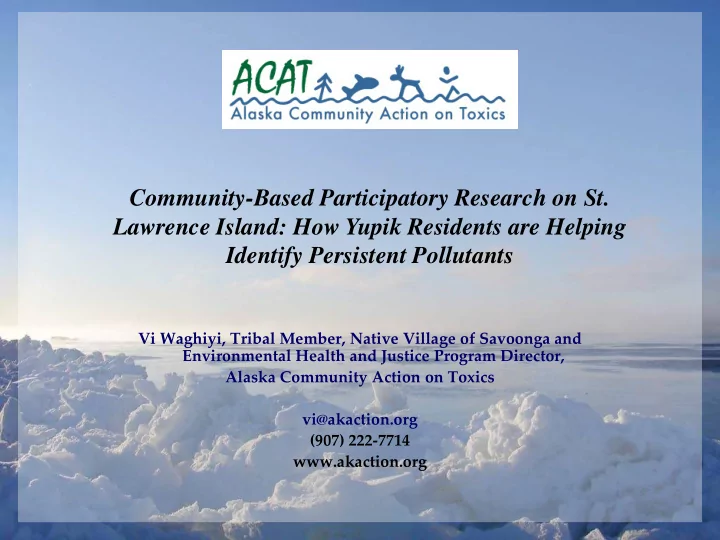

Community-Based Participatory Research on St. Lawrence Island: How Yupik Residents are Helping Identify Persistent Pollutants Vi Waghiyi, Tribal Member, Native Village of Savoonga and Environmental Health and Justice Program Director, Alaska Community Action on Toxics vi@akaction.org (907) 222-7714 www.akaction.org
Where is St. Lawrence Island? Located in the Northern Bering Sea
Voices of Our Ancestors
Traditional ecological knowledge is our foundation for living in harmony today “Our Traditional Ecological Knowledge is a way of life intended by our Creator to live in harmony with our lands, waters and environment. It is the foundation of our cultural beliefs. Foremost is the highest respect for our Creator and living as the Creator intended as keepers of our Mother Earth—as stewards, caretakers, conservationists, and scientists. We have our own laws which protect our communitie s.” —Delbert Pungowiyi, President, Native Village of Savoonga “We have always been a vigilant people. Our community- based research enables us to be vigilant at the molecular level.”— Merle Apassingok, Native Village of Gambell
Traditional ecological knowledge includes health, environment, and culture Our traditional knowledge is shared with each other. Our parents and grandparents are our first teachers. Our environment is well taken care of. We live in harmony with each other and take care of each other, our families, and our neighbors as one. We understand what is happening to our health and we have no doubt. Present day, we are not believed. It is so painful for our people.— Harriet Penayah, Elder and former Community Health Aide
Annie Alowa we remember her knowledge and forewarning as a respected • She was a keen and community health aide and elder trained observer about the health of her people • She observed higher rates of cancers among the people whose families lived and worked at Northeast Cape • She witnessed miscarriages and low birth weight babies, especially among those families closely associated with Northeast Cape • She inspires our work everyday!
700 active and abandoned military sites in Alaska—Many co-located with Alaska Native villages Norton Sound
PCBs in Blood Serum of St. Lawrence Island People Levels of PCBs in the blood Total Average PCB of St. Lawrence Island 12000 Yupik people 6-9 times higher than average in 10000 Concentration (pg./g) lower-48 populations 8000 Evidence of PCBs 6000 accumulating in the Arctic via global transport 4000 Military contamination also 2000 a significant source 0 Gambell NE Cape Savoonga Published in the International Journal of Circumpolar Health Average for populations in the Lower 48
Health Disparities Witnessed by the Yupik People of St. Lawrence Island— ” Diseases never or rarely seen before in our people… ” High rates of: Cancers—drastically increasing in our people since the military occupation; a cancer crisis Thyroid disease Diabetes Heart disease Low birth weight babies, premature births, still births, miscarriages Other reproductive health problems Learning and developmental disabilities
Global Transport of Persistent Chemicals into the Arctic
Contaminants in the North The north has become a hemispheric sink for pesticides and other industrial chemicals Northern food webs favor the deposition and retention of persistent, bio accumulative toxics Contaminants in the north threaten the health of peoples that rely on traditional diets of fish and marine mammals Global warming enhances the mobilization and transport of contaminants from local and distant sources
Results for PCBs Analysis of Traditional Foods on St. Lawrence Island Results published in the Journal of Toxicology and Environmental Health (2011). 74:1195-1214. Meats – ND (Walrus ) - 102.83 ppb (Bowhead) Fat/Blubber – 0.22 (Reindeer) ppb – 582.68 ppb (Polar Bear) Organs - ND (Reindeer liver, kidney) – 161.02 ppb (Bearded Seal Skin) Plants — 0.01 ppb (Greens) - 3.65 ppb (Salmon Berries) Marine Invertebrates — 0.18 ppb (Crab Meat) – 4.74 ppb (Sea Peaches/Upa)
EPA Fish Consumption Guidelines for PCBs Unlimited Consumption for non-cancer risks (all diseases except cancer): 5.9 ppb Unlimited Consumption for cancer risk: 1.5 ppb *As the levels go higher, the EPA recommends fewer meals per month* Example of EPA's Guidelines 100 ppb 300 ppb Non cancer risk No more than one meal No more than one meal (diseases other than cancer) a month every other month Cancer risk Do not eat Do not eat
17 Years of Community-Based Participatory Research and Policy Engagement Foundation of elder knowledge and community leadership Fostering collaborations with academic researchers Training of community health researchers Emphasis on community-right-to- know, capacity building and empowerment Community-based research Institute Training for health care providers Work on policy change with other environmental health and justice organizations on state, national, international levels
Community-based Research Institute
Organizing with Youth, Women, and Elders to Achieve Health, Human Rights, Environmental and Reproductive Justice ACAT staff and board with U.N. Rapporteur on the Rights of Indigenous Peoples Human rights training for youth 2 nd Norton Sound Indigenous Women’s Gathering 2017
Indigenous Peoples Have a Vital Role in Stockholm Convention
The Language of the Stockholm Convention “Aware of the health concerns…in particular impacts upon women and children and, through them, upon future generations.” “Conscious of the need for global action …” “Acknowledging that precaution underlies the concerns of all the Parties and is embedded within this Convention…” “Determined to protect human health and the environment…” “Acknowledging that the Arctic ecosystems and Indigenous communities are particularly at risk.. .”
“The chemicals present in our bodies are passed onto our Indigenous children and harm their ability to learn our languages, songs, stories, and knowledge.” Intervention of Vi Waghiyi, St. Lawrence Island Yupik Mother and Grandmother, Representing the Global Indigenous Caucus at the Stockholmm Convention on Persistent Pollutants in May 2015
Protecting Future Generations
“We don’t want any of you to fight with each other, but work together to clean it up for our sake.” – Annie Alowa Thank You. Igamsiqayugviikamsi
Join Us! www.akaction.org 907-222-7714 Join ACAT’s Facebook page Follow on Twitter
Recommend
More recommend